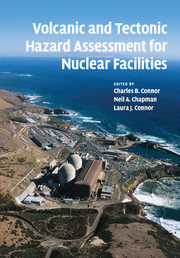Book contents
- Frontmatter
- Contents
- List of contributors
- Preface
- 1 Tectonic events and nuclear facilities
- 2 The nature of tectonic hazards
- 3 The nature of volcanism
- 4 Tectonic uplift and subsidence
- 5 Glacial isostatic adjustment: implications for glacially induced faulting and nuclear waste repositories
- 6 Using global positioning system data to assess tectonic hazards
- 7 Tectonic setting of volcanic centers in subduction zones: three-dimensional structure of mantle wedge and arc crust
- 8 Conceptual model for small-volume alkali basalt petrogenesis: implications for volcanic hazards at the proposed Yucca Mountain nuclear waste repository
- 9 Aspects of volcanic hazard assessment for the Bataan nuclear power plant, Luzon Peninsula, Philippines
- 10 Multi-disciplinary probabilistic tectonic hazard analysis
- 11 Tsunami hazard assessment
- 12 Regional-scale volcanology in support of site-specific investigations
- 13 Exploring long-term hazards using a Quaternary volcano database
- 14 Estimating spatial density with kernel methods
- 15 Cox process models for the estimation of long-term volcanic hazard
- 16 Spatial distribution of eruptive centers about the Idaho National Laboratory
- 17 Modeling the flow of basaltic magma into subsurface nuclear facilities
- 18 Intrusion dynamics for volatile-poor basaltic magma into subsurface nuclear installations
- 19 Volcanic risk assessment at Yucca Mountain, NV, USA: integration of geophysics, geology and modeling
- 20 Geological issues in practice: experience in siting US nuclear facilities
- 21 Characterizing active tectonic structures for nuclear facilities in Japan
- 22 Issues for coastal sites
- 23 Stable tectonic settings: designing site investigations to establish the tectonic basis for design and safety evaluation of geological repositories in Scandinavia
- 24 The impact of subsidence, uplift and erosion on geological repositories for radioactive wastes
- 25 Recommendations for assessing volcanic hazards at sites of nuclear installations
- 26 Formal expert assessment in probabilistic seismic and volcanic hazard analysis
- Index
- Map
25 - Recommendations for assessing volcanic hazards at sites of nuclear installations
Published online by Cambridge University Press: 27 May 2010
- Frontmatter
- Contents
- List of contributors
- Preface
- 1 Tectonic events and nuclear facilities
- 2 The nature of tectonic hazards
- 3 The nature of volcanism
- 4 Tectonic uplift and subsidence
- 5 Glacial isostatic adjustment: implications for glacially induced faulting and nuclear waste repositories
- 6 Using global positioning system data to assess tectonic hazards
- 7 Tectonic setting of volcanic centers in subduction zones: three-dimensional structure of mantle wedge and arc crust
- 8 Conceptual model for small-volume alkali basalt petrogenesis: implications for volcanic hazards at the proposed Yucca Mountain nuclear waste repository
- 9 Aspects of volcanic hazard assessment for the Bataan nuclear power plant, Luzon Peninsula, Philippines
- 10 Multi-disciplinary probabilistic tectonic hazard analysis
- 11 Tsunami hazard assessment
- 12 Regional-scale volcanology in support of site-specific investigations
- 13 Exploring long-term hazards using a Quaternary volcano database
- 14 Estimating spatial density with kernel methods
- 15 Cox process models for the estimation of long-term volcanic hazard
- 16 Spatial distribution of eruptive centers about the Idaho National Laboratory
- 17 Modeling the flow of basaltic magma into subsurface nuclear facilities
- 18 Intrusion dynamics for volatile-poor basaltic magma into subsurface nuclear installations
- 19 Volcanic risk assessment at Yucca Mountain, NV, USA: integration of geophysics, geology and modeling
- 20 Geological issues in practice: experience in siting US nuclear facilities
- 21 Characterizing active tectonic structures for nuclear facilities in Japan
- 22 Issues for coastal sites
- 23 Stable tectonic settings: designing site investigations to establish the tectonic basis for design and safety evaluation of geological repositories in Scandinavia
- 24 The impact of subsidence, uplift and erosion on geological repositories for radioactive wastes
- 25 Recommendations for assessing volcanic hazards at sites of nuclear installations
- 26 Formal expert assessment in probabilistic seismic and volcanic hazard analysis
- Index
- Map
Summary
Volcanic events are, at best, a parenthesis in current regulations or guidance for determining site suitability and for licensing decisions for most nuclear installations. This condition is understandable, as volcanic eruptions are rare natural events that have not created a significantly adverse condition at an operating nuclear installation. Nevertheless, unlike most geologic hazards, generally acceptable methodologies have not been established to assess volcanic hazards at a surface site or to determine if future volcanic events could be withstood by an appropriately designed nuclear installation. To address some of these challenges, the International Atomic Energy Agency (IAEA) has commissioned a multinational panel of consultants to revise preliminary guidance for assessing volcanic hazards at surface sites for nuclear installations. This chapter represents a summary of the consultants’ recommendations, which are being considered for adoption within an IAEA Safety Guide for volcanic hazards assessment.
The goal of this chapter is to formulate a systematic approach for evaluating volcanic hazards at any candidate surface site. The approach must be flexible enough to assess a broad range of complex, often interrelated volcanic phenomena, yet still provide a transparent methodology to support decision making. Two fundamental outcomes need to be supported by the volcanic hazards assessment. If the assessment determines that volcanic hazards are credible external events at a site, the results of the assessment will need to provide sufficient technical detail to support development of design bases or operational criteria to mitigate the effects of potential future events on safety (e.g. IAEA, 2003a).
- Type
- Chapter
- Information
- Volcanic and Tectonic Hazard Assessment for Nuclear Facilities , pp. 566 - 592Publisher: Cambridge University PressPrint publication year: 2009
- 5
- Cited by



